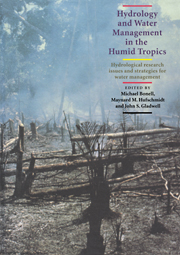 Hydrology and Water Management in the Humid Tropics
Hydrology and Water Management in the Humid Tropics Published online by Cambridge University Press: 23 December 2009
ABSTRACT
Aquifers underlie large areas of the humid tropics. Because of their widespread distribution, they can often be developed close to the location of demand, with modest pumping and reticulation costs, to produce groundwater of excellent chemical and microbiological quality requiring little treatment. These factors are leading to increased interest and rapid development of groundwater resources. Groundwater systems characteristic of the humid tropics fall into five main types, major alluvial formations, basement regoliths, intermontane valley-fill, active volcanic arcs and karstic limestones. The principal features of each of these are described and the main problems which arise in each case in the exploitation and management of groundwater resources are indicated. In the humid tropics, the close association between groundwater and surface water and the generally shallow water table make groundwater a valuable resource which, in some cases, is highly vulnerable to pollution from a range of human activities.
INTRODUCTION
Significance of groundwater
Aquifers underlie geographically large areas of the humid tropics. Because of this widespread distribution, their groundwater resources can often be tapped close to the location of water demand, thereby minimizing reticulation costs, at least for supplies up to moderate volume. Groundwater has other advantages for water supply development. Given adequate protection, it has excellent microbiological and organic quality, and requires minimal treatment. Although certain naturally- occurring dissolved chemical constituents can impart an unacceptable quality or a health risk for domestic supply, groundwater with these characteristics are of limited geographical distribution. The capital cost of groundwater development is thus relatively modest and the land requirements are minimal. Finally, the resource lends itself to flexible development, capable of being phased with rising demand.
To save this book to your Kindle, first ensure [email protected] is added to your Approved Personal Document E-mail List under your Personal Document Settings on the Manage Your Content and Devices page of your Amazon account. Then enter the ‘name’ part of your Kindle email address below. Find out more about saving to your Kindle.
Note you can select to save to either the @free.kindle.com or @kindle.com variations. ‘@free.kindle.com’ emails are free but can only be saved to your device when it is connected to wi-fi. ‘@kindle.com’ emails can be delivered even when you are not connected to wi-fi, but note that service fees apply.
Find out more about the Kindle Personal Document Service.
To save content items to your account, please confirm that you agree to abide by our usage policies. If this is the first time you use this feature, you will be asked to authorise Cambridge Core to connect with your account. Find out more about saving content to Dropbox.
To save content items to your account, please confirm that you agree to abide by our usage policies. If this is the first time you use this feature, you will be asked to authorise Cambridge Core to connect with your account. Find out more about saving content to Google Drive.